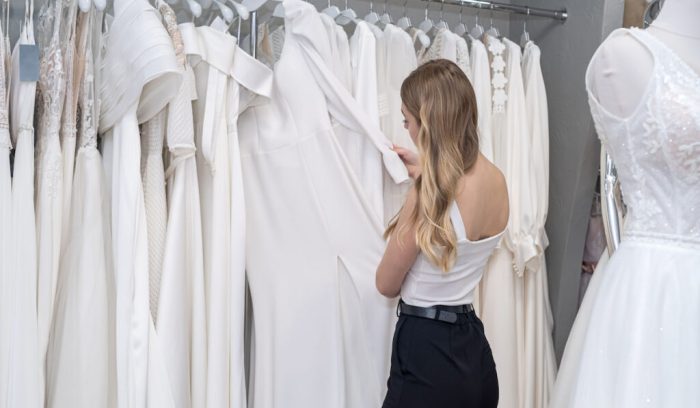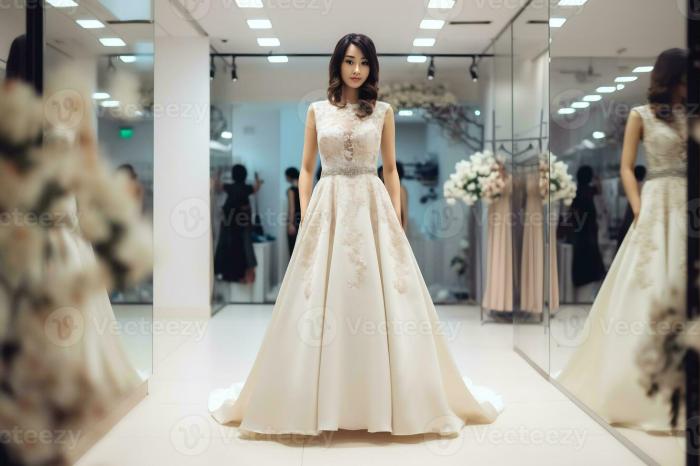
The Importance of Trying on Wedding Dresses Before Purchase
Wedding dresses try before you buy – Choosing a wedding dress is a significant decision, and trying it on before purchasing is crucial for ensuring a perfect fit, style, and overall experience. Failing to do so can lead to disappointment and unforeseen expenses. This section details the benefits of trying on wedding dresses, contrasts in-store versus online experiences, provides guidance for bridal appointments, and offers a checklist of questions for bridal consultants.
Benefits of Trying on Wedding Dresses Before Purchase
Trying on wedding dresses before buying offers several advantages. It allows you to assess the fit, feel the fabric against your skin, and visualize how the dress moves and drapes on your body. This hands-on experience is invaluable in determining if the dress complements your body type and personal style. Furthermore, it allows for adjustments and alterations to be considered before committing to a purchase, saving time and potential costs later on.
Finally, the in-person experience allows you to get a feel for the overall look and feel of the dress, which is difficult to gauge from online images alone.
Drawbacks of Buying a Wedding Dress Online Without Trying It On
Purchasing a wedding dress online without trying it on carries significant risks. Sizing inconsistencies between brands and styles can lead to an ill-fitting dress that requires extensive and potentially costly alterations. The fabric may feel different in person than it appears online, and the overall look and feel may not match your expectations. Returns and exchanges can be complicated and time-consuming, potentially delaying your wedding preparations.
The inability to see the dress in person eliminates the opportunity for a truly personalized experience.
In-Store vs. Online Dress Shopping Experiences

Source: vecteezy.com
The experience of trying on wedding dresses in a store is significantly different from ordering online. In-store shopping offers personalized assistance from bridal consultants, a wide selection of dresses to try on, and the ability to immediately assess fit, style, and comfort. Online shopping offers convenience and potentially lower prices, but lacks the personalized service and the opportunity for a physical assessment of the dress.
The lack of tactile experience and the potential for sizing discrepancies make in-store shopping generally preferable for a wedding dress purchase.
A Step-by-Step Guide to a Bridal Appointment
- Schedule an appointment in advance.
- Bring appropriate undergarments and shoes.
- Communicate your style preferences to the consultant.
- Try on several dresses to explore different styles and silhouettes.
- Take photos and videos to aid in decision-making.
- Discuss alterations and pricing with the consultant.
- Don’t rush the decision; take your time to consider your options.
Checklist of Questions to Ask a Bridal Consultant
- What is your selection process for choosing dresses?
- What is included in the price of the dress?
- What is your alteration policy?
- What is your return policy?
- Can I bring guests to my appointment?
Factors to Consider When Trying on Wedding Dresses
Several factors influence the choice of a wedding dress, including venue, body type, personal style, dress silhouette, neckline, fabric, and embellishments. Careful consideration of these elements ensures the chosen dress complements the bride’s figure, reflects her personality, and suits the wedding setting.
Key Factors Influencing Wedding Dress Choice
The wedding venue significantly impacts the style of dress. A beach wedding calls for a lighter, more flowing dress, while a formal ballroom setting might necessitate a more elaborate gown. Body type influences the choice of silhouette and neckline; certain styles flatter specific figures. Personal style dictates the overall aesthetic – classic, romantic, bohemian, modern, etc. These factors should be considered simultaneously to find the perfect dress.
Dress Silhouettes and Necklines
Different silhouettes (e.g., A-line, ballgown, mermaid, sheath) flatter different body types. Necklines (e.g., sweetheart, V-neck, halter, strapless) also play a crucial role in the overall look and how the dress complements the bride’s features. Experimenting with various silhouettes and necklines helps in finding the most flattering option.
Impact of Fabric and Embellishments

Source: bergamotbridal.com
The fabric and embellishments significantly impact the overall look and feel of the dress. Lace adds a romantic touch, while satin creates a sleek and sophisticated appearance. Beading, sequins, and embroidery add sparkle and texture. The choice of fabric should consider the season and venue; heavier fabrics are suitable for cooler settings, while lighter fabrics are ideal for warmer climates.
Accessorizing Wedding Dresses
Accessories complement the overall style of the dress. Veils, jewelry, and belts can enhance the look and add personal touches. Consider the dress’s style and embellishments when choosing accessories to ensure a cohesive and elegant look. Avoid overpowering the dress with excessive accessories.
Wedding Dress Fabrics
| Fabric | Season | Venue | Pros/Cons |
|---|---|---|---|
| Lace | Spring/Fall | Church, Garden | Pros: Romantic, delicate; Cons: Can be delicate, requires careful cleaning. |
| Satin | Any | Ballroom, Beach | Pros: Sleek, luxurious; Cons: Can be prone to wrinkles, shows imperfections. |
| Silk | Spring/Summer | Garden, Beach | Pros: Luxurious, breathable; Cons: Expensive, requires special care. |
| Tulle | Spring/Summer | Garden, Ballroom | Pros: Romantic, airy; Cons: Can be itchy, requires careful handling. |
Finding the Right Bridal Salon or Retailer: Wedding Dresses Try Before You Buy
Choosing the right bridal salon or retailer is essential for a positive and successful dress-shopping experience. This section provides guidance on selecting a retailer, scheduling appointments, managing expectations, and preparing for the appointment.
Questions to Ask Potential Bridal Salons, Wedding dresses try before you buy
- What designers do you carry?
- What is your price range?
- What is your appointment process?
- What is your alteration policy?
- Can I bring guests?
Comparing Bridal Retailers
Boutiques offer personalized service and curated collections, while department stores provide a wider selection but may lack the same level of personal attention. Online retailers offer convenience and potentially lower prices but lack the in-person experience. The best choice depends on individual preferences and priorities.
Scheduling Appointments and Managing Expectations
Schedule appointments well in advance, especially during peak seasons. Manage expectations by researching salons and designers beforehand. Be realistic about your budget and style preferences. Communicate clearly with the consultant about your needs and desires.
What to Bring to a Bridal Appointment
- Undergarments similar to what you plan to wear on your wedding day.
- Shoes that are similar in height to your wedding shoes.
- Photos of dresses you like.
- Your budget information.
- A friend or family member for support (optional).
Communicating Preferences to a Bridal Consultant
Clearly communicate your style preferences, budget, and wedding date to the consultant. Bring photos of dresses you like and describe the overall look and feel you’re aiming for. Be open to suggestions but don’t be afraid to express your preferences firmly.
Understanding Wedding Dress Alterations
Almost all wedding dresses require alterations to ensure a perfect fit. This section explains common alterations, budgeting, finding a seamstress, timelines, and questions to ask a seamstress.
Common Wedding Dress Alterations
Common alterations include adjusting the length, taking in the seams, altering the straps or neckline, and adding or removing embellishments. The extent of alterations depends on the dress and the bride’s measurements. A professional seamstress can assess the necessary adjustments during a fitting.
Budgeting for Alterations
Budget for alterations separately from the dress purchase. Alterations can range from a few hundred to several thousand dollars, depending on the complexity of the adjustments. Include this cost in your overall wedding budget.
Finding a Reputable Seamstress
Seek recommendations from friends, family, or bridal salons. Check online reviews and portfolios. Schedule consultations with several seamstresses to compare their services and pricing before making a decision. Ensure they have experience with wedding dresses.
Timeline for Wedding Dress Alterations

Source: mywhitesandwedding.com
Finding the perfect wedding dress is a journey, and trying before buying is crucial. You want to experience the drape and feel of the fabric, ensuring a comfortable fit. If you’re on a budget, exploring options like those found at wedding dresses less than 1000 can be a great starting point. Remember, prioritizing a try-on appointment helps avoid costly mistakes and guarantees you’ll feel stunning on your big day.
Allow ample time for alterations. Typically, several fittings are required, spanning several weeks or months. Begin the alteration process several months before the wedding to avoid rushing.
Questions to Ask a Seamstress
- What is your experience with wedding dress alterations?
- What is your pricing structure?
- What is your turnaround time?
- How many fittings are required?
- What is your cancellation policy?
Visualizing the Wedding Dress Experience
The bridal appointment is a significant moment in the wedding planning process. This section describes the atmosphere, emotions, and ways to manage stress during the dress shopping experience.
Atmosphere and Ambiance of a Bridal Appointment
The atmosphere of a bridal appointment is typically exciting and celebratory. Salons often create a luxurious and comfortable environment to enhance the experience. Soft music, elegant displays, and attentive consultants contribute to a positive and memorable experience. The overall ambiance should be relaxed and supportive.
Emotions Associated with Finding “The One”
Finding the perfect wedding dress often evokes a range of emotions, from excitement and joy to relief and even tears. It’s a deeply personal moment, representing a significant step in the wedding planning process. The feeling of finding “the one” is often described as a combination of excitement, satisfaction, and confidence.
Visual Representation of a Bride Trying on Dresses
Imagine a bride in a softly lit dressing room, her reflection shimmering in a large mirror. She gracefully steps into a flowing A-line gown, the fabric cascading around her. Next, she tries on a sleek sheath dress, its clean lines highlighting her figure. Finally, she slips into a romantic ballgown, its delicate lace and intricate beading creating a breathtaking effect.
Each dress transforms her, reflecting different aspects of her personality and style.
Positive and Negative Experiences During a Bridal Appointment
Positive experiences often involve finding the perfect dress with the help of a supportive consultant, feeling confident and beautiful in the chosen gown, and having a fun and memorable experience. Negative experiences might include feeling pressured, overwhelmed by the selection, encountering unhelpful staff, or not finding a dress that meets expectations.
Managing Stress and Anxiety During Dress Shopping
To manage stress, plan appointments in advance, create a realistic budget, communicate openly with your consultant, and bring a supportive friend or family member. Remember that the goal is to find a dress that makes you feel beautiful and confident. Don’t let the pressure of the process overshadow the joy of the moment.
Question & Answer Hub
What should I wear to my bridal appointment?
Wear comfortable undergarments similar to what you plan to wear under your wedding dress (e.g., a strapless bra or shapewear). Bring shoes that are similar in heel height to the shoes you plan to wear on your wedding day.
How long should a bridal appointment take?
Appointments typically last between one and two hours, but this can vary depending on the salon and your needs.
How many dresses should I try on?
There’s no magic number. Try on enough dresses to get a feel for different styles, but don’t overwhelm yourself. Focus on the styles and silhouettes that resonate with you.
What if I don’t find “the one” at my first appointment?
Don’t panic! Wedding dress shopping takes time. Schedule additional appointments at different salons to broaden your options.